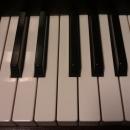Una descripción algo más detallada de cómo funcionan las zonas y cómo se modifican los "hex layers" en tiempo real.
Mike Martin escribió:There are a couple of ways to use the sliders and control how they work for each zone.
First, the Stage Setting is what determines the assignment for each Slider or Knob. Once you go into each Zone you can determine if the slider is enabled for the zone or not. Quick example using two simple sounds:
Zone1: Piano
Zone2: Strings
In this example, I could set:
Slider 1: CC#11 Expression
Slider 2: CC#11 Expression
Expression is a better choice that CC#7 Volume, I'll explain that later
Next for Zone1 (Piano) Controllers you select:
Slider 1: ON
Slider 2: OFF
For Zone 2 (Strings):
Slider 1: OFF
Slider 2: ON
This configuration will give me independent Expression control over each zone. With me so far?
Where the PX-5S gets a little deeper is that the sounds on Zone1 and Zone2 can be "Hex Layers", so each of them on their own can have up to six layers. So sliders an knobs can be set not only to control everything on a Zone using Expression (volume) control, but to control the "Layer Volume" of components within a zone.
Example if Zone 1 has a HexLayer sound that has six components - (WarmPad, VocalPad, Synthstrings, Sawtooth1, Sawtooth2, ElectricPiano)
You could use the six layers to blend those - by setting each Slider to "Layer1 Vol, Layer2 Vol, Layer3 Vol, Layer4 Vol...etc). But that is just Zone1, So you still might have piano sounds sound or something else on Zone2 and again you can choose if that Zone pays attention to each Slider or not.
The PX-5S has a couple other tricks up its sleeve.
Each Slider, Knob, Pedal and Modwheel can do 2 things at once. In addition their function can work in a normal or reverse way.
Example:
Zone 1: Piano
Zone 2: HexLayer with Strings (layer 1) and Choir (layer 2)
Slider1: CC#11 Expression
Slider2: Target 1 -> Layer1 Volume min:0 max:127
Slider2: Target 2 -> Layer2 Volume min:127 max:0
In this example Slider 2 has control over BOTH the strings and the choir. With Slider 2 in the middle, I can hear both. With Slider 2 up all the way I hear Strings and pulled down I'd only hear Choir.
Has your head exploded yet? Don't worry, there are many examples of things like this built-in to the Stage Settings on the PX-5S and we'll be making more that you can download,
Volume (CC#7) vs Expression (CC#11):
The major difference is that Volume will override any preset value. Expression will keep it relative.
Easiest Example is Piano and Strings:
Zone1 Piano - Volume 127
Zone2 Strings - Volume 100.
So lets say at these values, I have a nice balance between the two sounds. If I control the strings with CC#7 Volume, it could anywhere from a value of 0-127 (Potentially being too loud to hear my piano sound). If I use Expression - I can reduce the level of the strings but its maximum actual volume will never exceed the what I originally set. Make sense?
I'll give you some time time to swallow this one.








